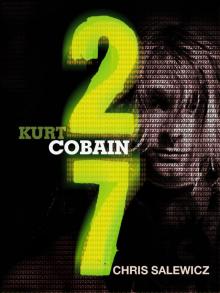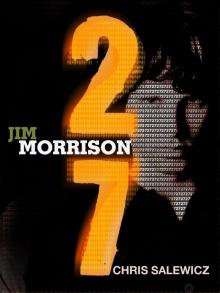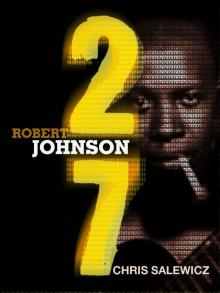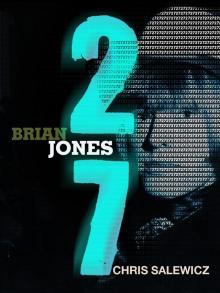- Home
- Salewicz, Chris
27: Kurt Cobain Page 4
27: Kurt Cobain Read online
Page 4
Jason Everman, prone to metal rock-star-like movements onstage that jarred with Kurt’s ‘purist’ posture, did not seem to fit in. On 18 July he played his last show with Nirvana, at the Pyramid Club in New York City, part of the New Music Seminar. His fate was sealed after Kurt and Krist got drunk one night – as they seemed to most nights – and then scored some cocaine. While high on the drug, the pair decided that Jason had to go. Jason later joined Soundgarden as bassist.
It was a three-piece Nirvana that undertook a fourteen-day Midwest tour that started at the end of September. The tour began in Minneapolis. That day Kurt suffered so much from stomach ache that he collapsed, violently vomiting, even when there was nothing left in his stomach. He was taken to a hospital but no specific condition was discovered.
Back in the studio, Nirvana recorded an EP, Blew, named after its title track. Other songs were the previously released ‘Love Buzz’, ‘Stain’ and ‘Been a Son’. Three thousand copies were pressed, but it was only released in the UK. There was a specific reason for this. On 20 October 1989, Nirvana and Tad, who would be topping the bill, boarded a plane in Seattle for the ten-hour flight to London, before driving three hundred miles to Newcastle in the north-east of England. This was the first of thirty-six shows in forty-two days. With eleven people jammed into a Fiat van it was almost impossibly claustrophobic, especially for someone claiming to suffer from a fear of confined spaces, as Kurt now was.
The upside was that almost all of the dates were sold out – Bleach was in the Top 10 of the UK indie album chart – including the show in Berlin the day after the Berlin wall had come down. Six songs into that show, Kurt destroyed his instrument and stormed off. Exhaustion seemed to have led to feelings of melancholy followed by downright depression. In Rome Kurt clambered up the speakers, then onto the balcony, still strumming his guitar, hollering at the audience that he was going to jump and kill himself. (‘Jump!’ called the audience.) Backstage he smashed microphones and burst into tears. Jonathan Poneman from Sub Pop was there. According to Kurt, as soon as he claimed to be leaving Nirvana, Poneman offered to sign him as a solo artist. But Bruce Pavitt and Poneman had made a major strategic error. They had arrived backstage at the Rome gig as a measure of support, flying in from Seattle. By thus indulging in long-distance air-travel, staying in hotels more luxurious than anything the band members had ever seen, they earned Kurt’s abiding enmity. ‘Though Nirvana would stay on Sub Pop for another year, in a progressively worsening marriage, Kurt had already emotionally jettisoned his label,’ said his biographer Charles R. Cross.[31]
Kurt pulled himself together and the tour moved back to London for its final show, on 3 December, at London’s Astoria. Although Melody Maker, which had championed Nirvana, turned against them, Keith Cameron of Sounds proclaimed them ‘the most amazing band I’d ever seen.’
The next day Nirvana recorded a session for John Peel, the revered BBC disc jockey and relentless champion of the underground.
Back in the USA, Nirvana played some Californian dates, before another national tour. Now they were pulling in audiences of a few hundred. Despite the buzz of being championed by Sonic Youth, who had come to see them on the previous tour, the band played badly at their New York Pyramid Club show. Sonic Youth’s Kim Gordon and Thurston Moore were in the audience, along with Iggy Pop; and, significantly, Gary Gersh, an A&R man for the Geffen label.
Despite their growing buzz, when Nirvana played a Seattle New Year’s Eve show at the end of 1989, only fifty people turned up. In the venue’s dressing room, Kurt wrote on a wall: ‘Do it again for another!’ – an expression of his altruism towards his fellow man. ‘He was so personable and so fucking cool,’ said his friend Amy Moon, who was there that night. ‘Kurt was totally a listener … One of the few people I’ve met who listened to what you said.’
Back in Olympia, in March 1990 Kurt and his friend Damon Romero decided one night to rent a video, choosing Alex Cox’s Straight to Hell, a spaghetti thriller starring former Clash singer Joe Strummer. Although the film had been critically trounced, Kurt – unsurprisingly – liked it. He and Romero also noted the presence in the film of a girl they had noticed in a club in Portland, Oregon: Courtney Love.
On 3 April 1990 Nirvana arrived at Smart Studios in Madison, Wisconsin, the premises of Butch Vig, not only a record producer but also a drummer. Kurt believed – correctly – that Vig could achieve the drum sound he felt was so absent from their recordings, and which increasingly he believed Chad was unable to deliver. In a week they recorded eight songs, including ‘In Bloom’, ‘Breed’ and ‘Pay to Play’. They were intended for the next Nirvana album, which Kurt had decided should be titled ‘Sheep’.
As doors were opening professionally for Nirvana, others were closing emotionally for Kurt Cobain, now once again drinking heavily. On Tracy’s birthday in late April, she received a phone call from Kurt, on tour. He told her that he still wanted to be her boyfriend, but no longer wanted to live with her. Unusually, Kurt then had sex with a girl while on the road in Texas, the one time his bandmates recalled him behaving in such a manner. He cursed himself afterwards for his weakness. It was an unsatisfactory, depressing experience, and he later told Tracy about it.
Nirvana were also aware that their relationship with Sub Pop was becoming problematic. Like many independent labels, Sub Pop was forever stymied by its distribution network. Nirvana would arrive on tour in a town and find no copies of Bleach in the local stores. By the summer of 1990, Sub Pop were aware that Nirvana had decided to leave the label.
Moreover, the group leaving Sub Pop would be without a drummer. In mid-June Kurt and Krist took the ferry over to Bainbridge Island to let Chad know that he was out of the group. The same week Tracy moved out of the apartment, which Kurt took over.
The truth was that Kurt had fallen for another girl, Tobi Vail, an Olympia musician a year younger than him with an enormous knowledge of punk music. She had also had a better education than Kurt. A feminist, who had coined the phrase ‘riot grrrl’ and was forming a band called Bikini Kill, Tobi’s rants about sexual politics fascinated Kurt – who was obliged to put to the back of his mind the porn magazines he had leered at in the van in Europe. However, as Charles R. Cross recalled, a person with such views was not precisely who Kurt was looking for: ‘What Kurt was searching for in a relationship was the kind of family intimacy he had lacked since early childhood; but Tobi rejected the traditional relationship he sought as sexist.’ Yet his endless late-night discussions – and less frequent late-night sex – with Tobi had been inspiring. ‘Punk rock is freedom’ was a rubric he coined while hanging with Tobi, and he would quote it at every opportunity.
Kurt and Krist were now sending cassettes of their Butch Vig sessions to major labels. Punk purist Tobi declared that she would never sign with a major. Did this manifest some inner conflict for Kurt Cobain? On a radio interview in April, he had declared: ‘We don’t have any interest in a major label. It would be nice to have better distribution, but anything else that goes on major labels is just a bunch of shit.’
Then Kurt did the precise opposite, enlisting the assistance of Susan Silver, Soundgarden’s manager. Kurt and Krist met Alan Mintz, a top-end Los Angeles-based music business lawyer who understood the Butch Vig tape, and vowed to sign them to a major. After the relative success of Bleach, and many positive reviews, there was already a considerable buzz over Nirvana.
Nirvana were scheduled to record another single for Sub Pop. They brought in Dan Peters from Mudhoney on drums and recorded the tune, ‘Sliver’, while Tad, busy recording an album, took time off for a meal. As far as Kurt’s writing went, ‘Sliver’ was a serious development. It told the autobiographical story of a boy who is left by his mother and father to be baby-sat by his grandparents. ‘It also,’ according to Charles R. Cross, ‘was one of the first Nirvana songs to use contrasting dynamics, which would become a signature for the band: the verses were quiet an
d slow, but the chorus came in as a thunderous wall of sound.’[32] The song ends with Greta Garbo’s moody (and misquoted) imprecation, ‘I want to be alone.’
For an August tour of the West Coast with Sonic Youth, Dale Crover was brought back in as drummer. When he had to return to the Melvins, in came Dan Peters, for a show on 22 September, at the Motor Sports International Garage in Seattle. Although Dale was told Nirvana were getting ready for a UK tour, he would not play with them ever again. In the audience was someone Buzz Osbourne had brought along – Dave Grohl. Grohl was legendary for the power with which he hit drums and for his across-the-kit attack in the group Scream, a Virginia hardcore outfit.
Dave Grohl had been born in Warren, Ohio, on 14 January 1969. At the age of twelve he had begun to play guitar. When he formed a punk band, Freak Baby, Dave became so dispirited by the ineffectual drummer he decided he could do better on the kit himself. At sixteen, Dave discovered Led Zeppelin and – specifically – the drumming of John Bonham.
Kurt and Krist had been in San Francisco and, hearing Scream had a great drummer, had gone to see them play there. Twenty days after the Motor Sports International Garage concert, Dave drummed for the first time with Nirvana at the North Shore Surf Club in Olympia. ‘We knew in two minutes that he was the right drummer,’ said Krist.
Almost immediately afterwards they were off to the UK for a five-date sell-out tour. ‘It looks like it’s gonna be pretty easy to find a big deal, we’ve just got to try to keep from being fucked,’ Kurt told Liz Evans for Raw magazine in England. Clearly he was utterly aware of Nirvana’s position and his group’s emerging potential. ‘It’s a hard problem,’ he agreed. ‘Because we feel that we’re diverse and accessible enough to try to infiltrate into more than just one market. We feel we can appeal to more than just the Metal or the Alternative Rock market. We want to try to be mainstream too. We want to reach the Top 40. Even if the whole of the next album can’t get across to that type of audience there’s at least a hit single or two in there.
‘Our next album is going to be so diverse that we really have no choice but to cross over. We can’t be classified into this simple heavy Grunge Rock category anymore. We’ve moved a long way on from there.’
Back in Seattle, Kurt and Krist were flown down to LA by MCA Records for an unfruitful meeting with label executives. Meeting up with Sonic Youth, who happened to be in the city, Nirvana were urged by these alternative standard-bearers to check out their own management, Gold Mountain, and to sign with Geffen Records – Sonic Youth were on the label’s DGC imprint.
In Olympia Dave Grohl moved in with Kurt, who had been living on his own and seemed in an increasing state of isolation, especially as he and Tobi were hardly seeing each other. Now, however, Dave started going out with Bikini Kill’s Kathleen Hannah, and Kurt and Tobi would often be with them. At Kurt’s house one night, Kathleen Hannah added a piece of graffiti to a wall in the apartment shared by the two Nirvana musicians: ‘Kurt smells like teen spirit,’ a reference to the Teen Spirit deodorant that Tobi used. By November, however, Tobi had dumped Kurt, which he did not take well. He retreated into himself again, often seeming to seethe with rage, his mental state exacerbating his permanent stomach pains.
But the breakup was positive for his art. In subsequent months he wrote a string of his best songs, all of them about Tobi, including ‘Aneurysm’, ‘Drain You’, ‘Lounge Act’ and – most significantly, of course – ‘Smells Like Teen Spirit’. He also introduced a new personality into the writings in his journal: her name was spelt ‘heroine’. This wilfully coy use of the word heroin – as though by so archly misspelling it, he removed the danger – perhaps concealed his true feelings about, or fear of, females. He promised Tracy, with whom he had had something of a reconciliation, that he only would do the drug occasionally.
When Kurt signed a publishing deal with Virgin, his first payment came as a $3,000 cheque. He spent $1,000 at Toys R Us, his purchases including a couple of air rifles, with which he shot out the windows at a nearby building housing the Washington State Lottery.
Days later, Nirvana were visited by John Silva, the partner of former Led Zeppelin publicist Danny Goldberg at Gold Mountain Management, who oversaw the career of Sonic Youth. Gold Mountain secured Nirvana a deal with DGC, the same Geffen imprint to which Sonic Youth were signed, for $287,000, a very substantial advance. (It was not until 30 April 1991 that the contract was finally completed.) From the advance Kurt received wages of $1,000 a month. Although for years he had been living on far less, the $250 a week was somehow never enough. After falling behind on his rent, Kurt for a time was reduced to living in his car. For much of the time he ate only corn dogs – hardly the best diet for a man incessantly plagued by violent stomach pains.
To record their first album – what would become Nevermind – Kurt and Krist wanted to continue working with Butch Vig. While they were in Los Angeles recording, Courtney Love began to call by to see Kurt. Since they had first met at a show in Portland in 1989, she had been very taken with him. ‘I just thought he was really beautiful. He was really cool and he had really beautiful hands,’ she said.[33] With worrying prescience, Kurt’s first impression of Courtney Love was that she looked like Nancy Spungen – ‘Nancy’ as in ‘Sid’n’Nancy’. Running into each other at a Butthole Surfers show at the Los Angeles Palladium, Courtney showed her affection for Kurt by hitting him in the belly, before – as though in some primitive mating ritual – they began wrestling with each other.
A highly intelligent woman, Courtney Love was clearly driven towards stardom. In March 1990, she had started the group Hole. A former stripper and Oregon reform school alumnus, she had lived in Liverpool in the UK, on the scene with the Teardrop Explodes and Echo and the Bunnymen. She had also had a film part – the one Kurt had seen – in Alex Cox’s Straight to Hell. And she could talk until hell froze over. According to her former longstanding boyfriend from Portland, Courtney’s ambition was tempered by conventional belief: ‘She thought it was a male-dominated world. She thought the only way she could achieve stardom was through a man.’
At first Kurt was intent on not getting into another relationship. His purpose in Los Angeles was to make a successful album; he was inspired by the city’s spirit-lifting ceaseless sunshine, a considerable contrast to that of Seattle. Sound City Studios in Van Nuys in the San Fernando Valley was the reasonably priced recording complex recommended to Nirvana by DGC. The first record made there had been Neil Young’s masterly After the Goldrush. Later in the 1970s Fleetwood Mac had recorded their enormously successful Rumour album at Sound City. As Kurt was not acquainted with any local heroin dealers, he resorted to drinking codeine-based cough syrup throughout the sessions. Purist Kurt would often refuse to record a second take.
The record was finally mixed by Andy Wallace, who had worked magic on Slayer’s Seasons in the Abyss. ‘Wallace sweetened the sound, filtering the raw tracks through various special effects boxes, cranking out about one mix a day,’ said Azerrad.[34] The record was completed, at a cost of $65,000, by mid-June 1991. Almost immediately Kurt found himself suffering from that sense of being utterly underwhelmed and empty – on top of the overriding depression to which he was always prone – that often follows the successful completion of creative work.
But for now it was on with the show. Nirvana undertook a week-long West Coast tour, supporting Dinosaur Jr. The shows, which included dates in Denver, Los Angeles and Santa Cruz, were notable for revealing the audience’s air of expectation about Nirvana.
Then, in August, it was back to Europe. Once again, Nirvana were the opening act for Sonic Youth, on a tour with plenty of festival dates. On 23 August, they played Reading Festival, on the main stage at 2 p.m, before a 50,000-strong audience. Flinging himself into the drum kit, Kurt suffered a minor shoulder dislocation. Backstage was Courtney Love, with her then boyfriend Billy Corgan of Smashing Pumpkins.
Back on the West Coast,
at a sound stage in Culver City in Los Angeles, Nirvana filmed a video for ‘Smells Like Teen Spirit’. It was a parody of a high school gym performance, with an elderly janitor mopping the floor – as Kurt had done at his former high school.
The cover image for Nevermind was established. It featured a picture of five-month-old Spencer Elden, a naked baby swimming. At least subconsciously, this was an expression of the excess of water signs in Kurt’s astrological chart. This was something he was acutely aware of, and a clue to his almost overwhelming sensitivity – he would even refer to his astrological sign in his eventual suicide note. An addition to the image was a dollar bill suspended in the water to which the baby appeared to be heading – a twist that was Kurt’s idea. The baby’s penis was clearly visible, surviving suggestions from censorship-wary DGC employees that it might require airbrushing out.
As though facing down fate, Nevermind was released on Friday, 13 September 1991, with an album launch party in Seattle. Kurt found himself embarrassed at how the local scene would respond to his record company’s inevitable overzealous dressing of the hip Re-bar with a myriad Nirvana posters. Neatly pressed company employees had flown up en masse from LA. After Nevermind had been played twice, a cringing Kurt had the DJ replace the Nirvana music with cheesy disco and New Wave. Then the event erupted into a food fight, at which point Nirvana were asked to leave.

 27: Kurt Cobain
27: Kurt Cobain 27: Jim Morrison
27: Jim Morrison 27: Robert Johnson
27: Robert Johnson 27: Brian Jones
27: Brian Jones